One of the most commonly asked questions, when we are running courses, is ‘Will we find any Truffles today?’ unfortunately my answer is almost always no, through this guide we’re going to look at An Introduction to Truffles in case you happen to be lucky enough to stumble across some of these prized delights..
Although we do offer specific days where we go truffle foraging in the UK – keep a close eye on our Courses page as they do tend to sell out! 🙂
We do find lots of edible, gourmet mushrooms, but Truffles are a different thing altogether, and without a dog or pig it’s like looking for a needle in a haystack, although I have seen people find them with their own nose before 🙂
Most of us have heard of Truffles or seen them used by chefs on TV but what is all the fuss about?
What are Truffles?
Truffles are the fruiting bodies of subterranean ascomycete fungus, usually one of the many species of the genus Tuber.
All Truffles form mycorrhizal relationships with trees (this means they live with the roots of trees only – most often with beech, birch, hazel, hornbeam, oak, pine, and poplar) and they develop at the base of these species just beneath the surface.
Unlike a lot of mushrooms which use gills to disperse their spores, the ascomycete or sac fungi produce their spores internally and as such have no way of dispersing them on their own. Instead, they rely on fungivores, (animals that eat fungi) such as rodents, humans and slugs to carry them to new sites.
There are many species of Truffle, not all of them are prized by chefs. The main species of interest are:
White Truffle (Tuber magnatum)
They are known as “Truffle of the White Madonna” in Italy. The record price for truffle is £165,000 for a specimen that weighed 1.5 kg!!!
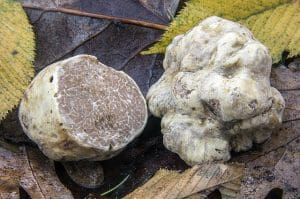
Black Truffle (Tuber melanosporum)
A delicious and much sought after fungus, they are one of the most expensive fungi in the world, second only to the White truffle.
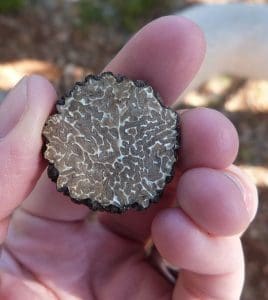
Whitish Truffle (Tuber borchii)
They grow near oaks and pines. They are very, very rarely found in the UK and are most often found in Italy and Spain.
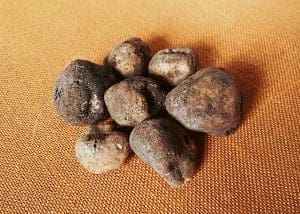
Autumn Truffle (Tuber uncinatum)
They are native to the UK, more common in the south of the country but they have been found as far north as the Peak District and Yorkshire.
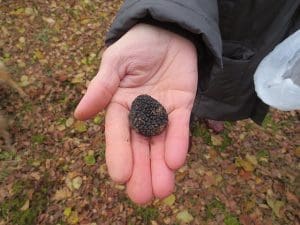
Summer Truffle (Tuber aestivum)
They’re not as well-known as their continental cousins The Périgord Black (Tuber melanosporum) and The Italian Piedmont White (Tuber magnatum), but they are still a fantastic ingredients when you can find them.
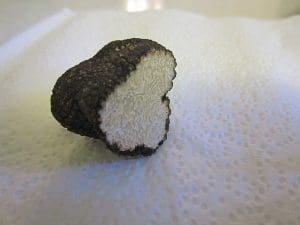
Why are truffles so prized?
They are hard to find in the wild and have a relatively short season. In the past they were thought to occur after lightning strikes so that also probably added to their allure.
Even if they are cultivated, the trees are expensive and they take up to 10 years before the truffles appear. There’s also a high risk of failure.
Their ellusiveness and rarity is what, I believe, makes them so highly prized and exciting.
What do truffles taste like?
Everyone’s taste is different and each species has a slightly different flavour but most say they taste earthy, nutty and garlicky. I don’t think any of these descriptions really do them justice, they are intoxicating and almost addictive.
They also have a lovely musky aroma that I can’t get enough of.

How do you use truffles?
Chefs love the earthy, umami flavour that they bring to savoury dishes and usually use them grated or finely sliced.
They’re rich in umami so enhance most dishes, most famously there served with pasta or meat.
Truffle oil is a good, less expensive way to taste this fungal treat. But look for one made with actual truffles rather than one artificially flavoured or blended. Remember a little goes a long way, so buy a small bottle of the best you can afford.
If you do get some fresh truffles, a good way to make the most of them is to store them near eggs or rice. Over a couple of days, the truffle imparts its flavour without costing a penny.
Can I find Truffles in the UK?
Yes, you can find Truffles in the UK, the earliest mention of them was in 1693 by the Physician and Naturalist Tancred Robinson. They are also written about by Mrs Beeton and Rudyard Kipling. Truffles have been hunted in Britain since the 17th century although the practice seemed to die out around the 1930s for many reasons.
Unfortunately, the most highly prized Black or White and Whitish Truffles aren’t native to the UK, however there is reports of people find the Whitish Truffles in the UK, in August 2023 we received this image where Allison and here family found Whitish Truffles in their Garden, located in Lanarkshire, Southern Scotland – so it’s not impossible, just quite rare.

There is two main gourmet, edible Truffles that are found here are they are more common than people think.
In the UK we mainly get these two Truffles:
Autumn Truffle (Tuber uncinatum)

and the
Summer Truffle (Tuber aestivum).

Although not as famous as their continental cousins they are still a fantastic ingredient and add a lovely fungal, earthy note to dishes.
Where do I look for Truffles?
They are mycorrhizal with a few tree species such as oak, hazel, birch, holly and hornbeam, but as well as having the correct partner trees the right soil type is also required.
They prefer calcareous soils, so knowing the underlying bedrock is important. There is a huge band of calcareous rock running diagonally across parts of the Somerset, Dorset, Wiltshire, Gloucester, Hampshire, Berkshire, Kent, Hertfordshire, and parts of Northampton, Norfolk, and Lincoln and up into Yorkshire.
Look for large woods rather than individual trees, look in these areas and who knows you might be in luck.
Often you’ll see some damage around the base of these trees where squirrels and other animals have been digging for the truffles – this is one of the first indicators. Then on your hands and knees for a good sniff or send in a trained dog and cross your fingers and toes.
How do I Find Truffles?
Before you get too excited about becoming a millionaire truffle hunter, they are a rare find for most.
They are normally just below the surface and unless you have a trained pig or dog you’re just hoping that they pop up above ground after heavy rain.
I’ve read loads of articles and watched videos about hunting truffles without an animal but I don’t think it really worth the time and effort involved and in fact, it may be damaging. You’re told to look for ‘Brule’ for patches of ground that look burnt near suitable trees and then to dig around. I’ve never found any using this method and won’t do it again as I’m concerned about the potential damage I’m causing the underground mycelium of other species.
Another method involves looking for a fly that lays its larva on the truffle. Suilla flies can be seen flying above truffles and entering holes to get to them. The theory is that you spot the fly and dig around the entre hole, but you need good eyesight and a lot of patience to spot them
That said I do know of a talented herbalist who can smell truffles. When he has selected a promising looking tree he gets down and smells the ground. He’s about 90% accurate but he has nose skills most of us will never have.
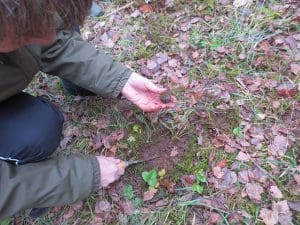
Do you use Pigs or Dogs for hunting Truffles?
Traditionally female pigs were used to hunt truffles, this is because truffles contain androstenol, a sex hormone found in the saliva of male pigs. (The same substance is in human sweat so that may be why they’re said to be an aphrodisiac)
Pigs eat them if given the chance, whereas dogs are more obedient so are used more nowadays.
In some areas of Italy, it is now illegal to use pigs due to the damage they can cause to underground mycelium networks.
The main breed of dog used is the Lagotto Romagnolo but many breeds such as spaniels and poodles are also used.
If you are interested in teaching your dog to hunt Truffles there are a few companies that offer training, but it’s very similar to training your dog to do anything, lots of time and patience on the trainers side, repetition and plenty of high rewards for the dog.
How to Train Truffle Dog?
When James trained his dog up to hunt truffles he took a set of steps during training (Using a Spaniel Dog)

- Three cups upside down, pop a bit of cheese (or other high reward) under one and have your dog find it
- Then train them to sit down when they’ve found it
- Then train them to sit down and paw at the cup when they’ve found it
- Then add truffle in the cup with the cheese (or a bit of cloth with truffle oil on)
- Then remove the cheese so they’re now just finding truffles (reward with cheese still – or other high rewards)
- Then have the dog sit in a different room whilst prepping the cups
- Then move the cups to more elaborate hiding places so the dog has to work harder and sniff more to find it
- Then remove the cup altogether & hide the truffle or truffle cloth around the house and garden
- Then head to a woodland and bury a set of truffles or truffle cloths (make sure to mark for yourself where you’ve buried them & have the dog find them.
- Repeat this last step over and over
- You’re ready to go 🙂
Remember this is a game for the dog so make sure to keep it incredibly fun for them with lots of happy noises and plenty of treats. It’s also an extremely good way to tire the dog out.
Is there anything that looks similar to Truffles?
In the UK there are very few lookalikes, most fungi that do look similar such as Puffballs (Lycoperdon) and Earthballs (Scleroderma) appear above ground.
Truffles do occasionally make it to the surface after very heavy rains so if you think that you may have spotted one I’d recommended cutting it in half. It should be solid and have a maze like appearance.
Puffballs are white in the centre (when young) and are spongy.
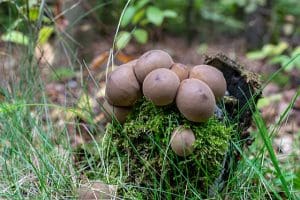
Earthballs are filled with a mass of spores that are dark purple to black. Both also lack the pungent aroma of Truffles
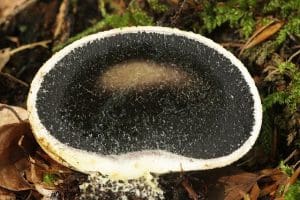
Can you Grow Truffles?
Truffles have been cultivated in Europe since the 1800’s. Acorns taken from trees known to produce truffles were planted and the trees did produce truffles. Truffle cultivation became very popular and by the end of the 19th century France had 190,000 acres of truffle-producing trees had been planted. Unfortunately the World Wars that followed brought an almost complete end to this industry.
There has been a resurgence in truffles in the last couple of decades and interest in cultivating them has grown. New techniques have allowed truffles to be grown in many parts of the worlds and it’s and fast growing industry. Up to 80% of truffles from France are cultivated.
There are many suppliers now selling inoculated tree saplings that you can plant at home but remember you need the right tree, spores and soil.
Where do you buy truffles?
I’d suggest buying them from a reputable dealer, it has been known for some to adulterate or pass off inferior truffles.
If possible it’s good to handle them before you buy. They should feel firm and heavy for its size. If they feel soft or light that’s typically a sign of decay.
They should be highly fragrant as the perfume quickly disappears. Some dealers have been known to spray truffle oil on to older specimens to make them more aromatic.
Brush off any dirt before they are weighed otherwise you’re just paying for mud!
As I said you’re best paying a bit more and getting them from a reputable dealer rather than buying them online.
Good luck and Happy Foraging!
References and further reading:
https://www.healthline.com/nutrition/truffles
http://www.telelib.com/authors/K/KiplingRudyard/prose/ThyServantADog/teem.html
2 replies on “Truffles: A Great Introduction to Truffles”
Leave a Reply
You must be logged in to post a comment.



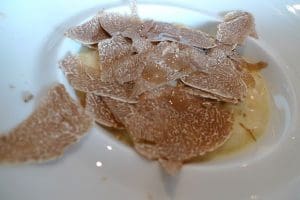
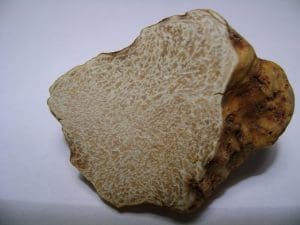
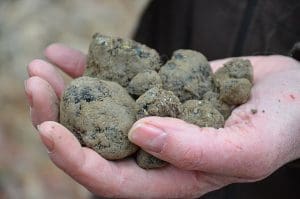



What is the spore test for black september truffels in scotland ?kind regards miss c murray.
Hey Catherine, you shouldn’t need to do a spore print for one of the truffles 🙂 Well done if you’ve found some – really exciting!